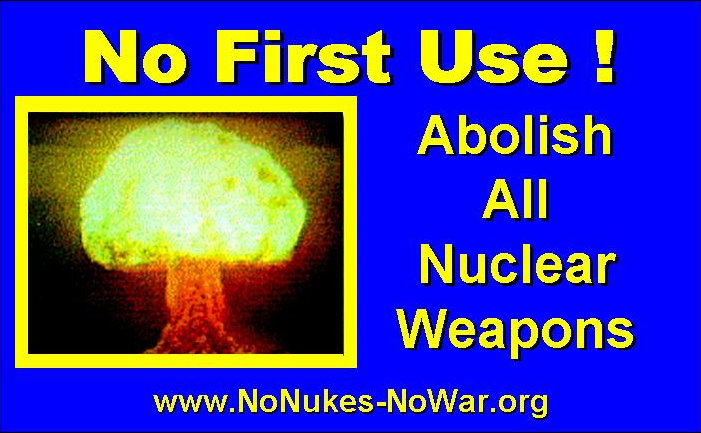 |
No
Nukes ! |
|
|
|
Hiroshima / Nagasaki Remembrance Speak Out Against New Forms of Nuclear Weapons Thursday, August 6th 2009 5:30 PM Picnic with conversations about nuclear weapons
and Bring your picnic basket and we will provide lemonade and chips
For Press Release and Press Briefing Paper click => here For a flyer (pdf), click => here NEWS RELEASE for 2009 July 27, 2009 (tentative release date for press release) Hartford Area 64th Anniversary Remembrance of Hiroshima / Nagasaki For Immediate Release Hartford, CT: The Connecticut Coalition For Peace and Justice (CCPJ) and the American Friends Service Committee (AFSC) announce a remembrance ceremony marking the 64th Anniversary of the United States nuclear bombing of Hiroshima and Nagasaki. The remembrance ceremony will be held Wednesday, August 6th at 6:45 PM at Riverside Park in Hartford (Jennings Road Exit). The event will be preceded by a picnic that starts at 5:30 PM. Bring your picnic basket and we will provide lemonade and chips. In 2005, twenty-one mayors and selectmen in Connecticut have publicly endorsed the resolution of the U.S. Conference of Mayors calling for negotiations to abolish nuclear weapons in accordance with Article 6 of the Nuclear Non-Proliferation Treaty (NPT) that was signed by 188 nations in 1970. The endorsements are part of a Global Campaign conducted by the Mayors for Peace that garnered the support of over 1000 Mayors throughout the world. One part of the Nuclear Non-Proliferation Treaty that is well known is the pledge of non-nuclear nations to forego developing nuclear weapons of their own. However, it is nearly unknown and disregarded in the United States that this promise is only half of the bargain that was struck in the Non-Proliferation Treaty. The other half of the bargain was that those nations who did have nuclear weapons were to negotiate their elimination on a mutually agreeable basis. Thousands of events are scheduled worldwide on August 6th and 9th to commemorate the 64th Anniversary of the nuclear bombing of the Japanese cities of Hiroshima and Nagasaki that resulted in over 200,0000 civilian deaths and the total destruction of these cities. While popular "wisdom" is that these nuclear bombs were needed to hasten the end of the war with Japan, declassified government documents strongly suggest that the more significant reason was the need to intimidate the Soviet army that was descending upon Japan and Korea in the summer of 1945. In fact, the Soviet army entered the war against Japan on August 8th, the day before the Nagasaki bomb. The dropping of the bombs at the end of World War II ushered in the nuclear weapons age and on its heels the ensuing global campaign for the total abolition of nuclear weapons. As a final note on the argument that the atomic bombing of Hiroshima and Nagasaki hastened the end of the war with Japan, "it is also a fact that even after Hiroshima and Nagasaki were destroyed, the Japanese still insisted that Emperor Hirohito be allowed to remain emperor as a condition of surrender. Only when that assurance was given did the Japanese agree to surrender. This was precisely the clarification of surrender terms that many of Truman's own top advisors had urged on him in the months prior to Hiroshima[ 'The Historians' Letter To The Smithsonian On The Enola Gay Exhibit', to Mr. I. Michael Heyman, Secretary, The Smithsonian Institution, July 31, 1995]." BACKGROUND Since 1945, beginning with the first resolution of the newly formed United Nations in San Francisco, there have been both nuclear proliferation and international governmental efforts to ban the bomb. Along with the United States, the former Soviet Union, China, France and England became the first five nuclear weapons states. In 1974, India, then Israel and later Pakistan joined the nuclear club. South Africa also joined this club but dismantled its weapons before the fall of Apartheid. International negotiations to rid the world of nuclear weapons led to banning of nuclear weapons testing above ground; the anti-ballistic missile defense treaty (ABM); the Nuclear Non-Proliferation Treaty; several weapons reduction treaties between the United States and the Soviet Union and its successor, Russia. Abolition of Nuclear Weapons has long been a goal of the United States. Negotiations between the United States and the Soviet Union, represented by General John J. McCloy and Soviet Ambassador Valerian Zorin, resulted in the historic September 20, 1961 "Agreed Principles" outlining a total disarmament treaty. This Kennedy Administration era treaty was never presented to Congress for ratification. A Comprehensive Test Ban Treaty (CTBT) was finally signed in 1996 but the United States Senate failed to ratify the agreement. During this entire period, more powerful nuclear and hydrogen bombs were developed that were many times more powerful than those dropped on Hiroshima and Nagasaki. Under the Bush administration, the anti-ballistic missile defense treaty (ABM) has been rebuffed and the commitments made under Article 6 of the Nuclear Non-Proliferation Treaty have been declared irrelevant. The Bush Administration, as did previous Administrations, continues to fund research and development of smaller and more deadly nuclear weapons. The Bush Administration has declared - and undertaken - a policy of pre-emptive strike including the option of using nuclear weapons. In May 2005, the recently concluded Final Review Conference of the Nuclear Nonproliferation Treaty at the United Nations, with the participation of 188 nations, ended without any agreement to deal with previous commitments. Central to these previous commitments were the obligations to negotiate for the total abolition of nuclear weapons and develop movement to ratify the Comprehensive Test Ban Treaty. For more information, please contact: Joe Wasserman, Connecticut Coalition for Peace and Justice, (860)
561-1897, <joewass64@yahoo.com> References: http://www.fas.org/spp/starwars/offdocs/jfk/ Press release in MicroSoft Word format click => here BACKGROUND FROM PREVIOUS PRESS RELEASES From their very inception, opposition to nuclear weapons arose even among the scientists who worked on the Manhattan Project. The Manhattan Project was the name given to the secret program to build atomic bombs. Aware of the inherent dangers of the weapons that could only be used against cities and civilians, famous scientists led by the theoretical physicist, Albert Einstein, appealed to President Harry Truman not to use the bombs. Since 1945, beginning with the first resolution of the newly formed United Nations in San Francisco, there have been both nuclear proliferation and international governmental efforts to ban the bomb. Along with the United States, the former Soviet Union, China, France and England became the first five nuclear weapons states. In 1974, India, then Israel and later Pakistan joined the nuclear club. South Africa also joined this club but dismantled its weapons before the fall of Apartheid. International negotiations to rid the world of nuclear weapons led to banning of nuclear weapons testing above ground; the anti-ballistic missile defense treaty (ABM); the Nuclear Non-Proliferation Treaty; several weapons reduction treaties between the United States and the Soviet Union and its successor, Russia. Abolition of Nuclear Weapons has long been a goal of the United States. Negotiations between the United States and the Soviet Union, represented by General John J. McCloy and Soviet Ambassador Valerian Zorin, resulted in the historic September 20, 1961 "Agreed Principles" outlining a total disarmament treaty. This Kennedy Administration era treaty was never presented to Congress for ratification. A Comprehensive Test Ban Treaty (CTBT) was finally signed in 1996 but the United States Senate failed to ratify the agreement. During this entire period, more powerful nuclear and hydrogen bombs were developed that were many times more powerful than those dropped on Hiroshima and Nagasaki. Under the Bush administration, the anti-ballistic missile defense treaty (ABM) has been rebuffed and the commitments made under Article 6 of the Nuclear Non-Proliferation Treaty have been declared irrelevant. The Bush Administration, as did previous Administrations, continues to fund research and development of smaller and more deadly nuclear weapons. The Bush Administration has declared – and undertaken - a policy of pre-emptive strike including the option of using nuclear weapons. This last May, the recently concluded Final Review Conference of the Nuclear Nonproliferation Treaty at the United Nations, with the participation of 188 nations, ended without any agreement to deal with previous commitments. Central to these previous commitments were the obligations to negotiate for the total abolition of nuclear weapons and develop movement to ratify the Comprehensive Test Ban Treaty. References: |
|
